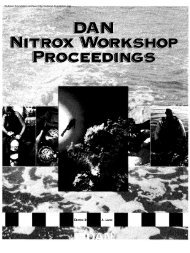Report on Decompression Illness, Diving Fatalities and Project Dive
Report on Decompression Illness, Diving Fatalities and Project Dive
Report on Decompression Illness, Diving Fatalities and Project Dive
- No tags were found...
Create successful ePaper yourself
Turn your PDF publications into a flip-book with our unique Google optimized e-Paper software.
Secti<strong>on</strong> 6 - Breath-Holding Incidentsdiver who still was still wearing his weight belt when help arrivedat his surface positi<strong>on</strong>. The victim described his c<strong>on</strong>diti<strong>on</strong> immediatelyprior to rescue as impending blackout. Ditching the belt at anypoint in the development of this incident would probably have beenan effective self-rescue.Equipment Problems: The records c<strong>on</strong>tain at least <strong>on</strong>e case of adiver who became unc<strong>on</strong>scious as he neared the surface duringascent from a breath-hold dive <strong>and</strong> quickly sank bey<strong>on</strong>d the pointat which those <strong>on</strong> the surface could reach him. Weighting duringbreath-hold diving may be c<strong>on</strong>sidered to optimize performance, butthe more important c<strong>on</strong>siderati<strong>on</strong> of weighting is for safety. Abreath-hold diver should be slightly positively buoyant close to thesurface to minimize the risk of sinking should a problem develop inshallow water.Impaired Health <strong>and</strong> Fitness: The available records c<strong>on</strong>tain at leastthree fatal cases involving heart trouble, three involving seizure <strong>and</strong>at least <strong>on</strong>e involving inadequate fitness that resulted in a doublefatality. The dem<strong>and</strong>s of breath-hold diving can be significant, particularlyin open water where rough water or currents may have tobe overcome. Inadequate fitness reserves may leave breath-holddivers unable to cope with normal challenges that can arise.6.4 SummaryWhile a small number of high profile fatality cases may be widelyreported, limited informati<strong>on</strong> is available for most breath-hold accidents.N<strong>on</strong>-fatal incidents are rarely reported. Data from both fatal<strong>and</strong> n<strong>on</strong>-fatal cases would provide valuable informati<strong>on</strong> to improveawareness, facilitate training <strong>and</strong> promote procedural evaluati<strong>on</strong>s.This is the first annual report to incorporate a review of breath-holdincident data. Breath-hold incident data reviews will be a st<strong>and</strong>ardcomp<strong>on</strong>ent of future annual reports.98DAN’s <str<strong>on</strong>g>Report</str<strong>on</strong>g> <strong>on</strong> Decompressi<strong>on</strong> <strong>Illness</strong>, <strong>Diving</strong> <strong>Fatalities</strong> <strong>and</strong> <strong>Project</strong> <strong>Dive</strong> Explorati<strong>on</strong>: 2005 Editi<strong>on</strong>
















